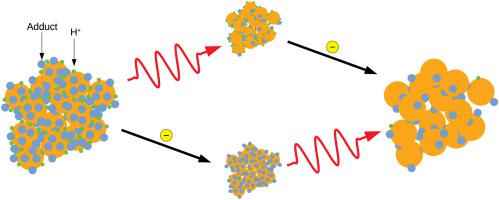当前位置:
X-MOL 学术
›
Int. J. Mass Spectrom.
›
论文详情
Our official English website, www.x-mol.net, welcomes your
feedback! (Note: you will need to create a separate account there.)
Digital Ion Trap Mass Analysis of High Mass Protein Complexes Using IR Activation Coupled with Ion/ion Reactions
International Journal of Mass Spectrometry ( IF 1.6 ) Pub Date : 2020-12-01 , DOI: 10.1016/j.ijms.2020.116437 Kenneth W Lee 1 , Christopher P Harrilal 1 , Liangxuan Fu 1 , Gregory S Eakins 1 , Scott A McLuckey 1
International Journal of Mass Spectrometry ( IF 1.6 ) Pub Date : 2020-12-01 , DOI: 10.1016/j.ijms.2020.116437 Kenneth W Lee 1 , Christopher P Harrilal 1 , Liangxuan Fu 1 , Gregory S Eakins 1 , Scott A McLuckey 1
Affiliation

|
Native mass spectrometry (MS) focuses on measuring the masses of large biomolecular complexes and probing their structures. Large biomolecular complexes are readily introduced into mass spectrometers as gas-phase ions using electrospray ionization (ESI); however, the ions tend to be heavily adducted with solvent and salts, which leads to mass measurement errors. Various solution clean-up approaches can reduce the degree of adduction prior to introduction to the mass spectrometer. Gas-phase activation of trapped ions can provide additional adduct reduction, and charge reduction ion/ion reactions increase charge state separation. Together, gas-phase activation and charge reduction can combine to yield spectra of well separated charge states for improved mass measurements. A simple gas-phase collisional activation technique is to apply a dipolar DC (DDC) field to opposing electrodes in an ion trap. DDC activation loses its efficacy when ions are trapped at low q values, which is true of the high m/z ions generated by charge reduction ion/ion reactions. Digital ion trapping (DIT) readily traps high m/z ions at higher q values by varying trapping frequency rather than amplitude, but the low frequencies used to trap high m/z ions also decreases the efficacy of DDC activation. We demonstrate here using ions derived from GroEL that IR activation of ions shows no discrimination against high m/z ions trapped with DIT, because they can be focused equally well to the trap center to interact with the IR laser beam. Following pump out of excess background gas, IR activation can also induce efficient dissociation of the GroEL complex. This work demonstrates that IR activation is an effective approach for ion heating in native MS over the unusually wide range of charge states accessible via gas-phase ion/ion reactions.
中文翻译:

使用 IR 激活结合离子/离子反应对高质量蛋白质复合物进行数字离子阱质量分析
原生质谱 (MS) 专注于测量大型生物分子复合物的质量并探索它们的结构。使用电喷雾电离 (ESI) 可以将大的生物分子复合物作为气相离子轻松引入质谱仪;然而,离子往往会与溶剂和盐严重加成,这会导致质量测量误差。各种溶液净化方法可以在引入质谱仪之前降低加合程度。捕获离子的气相活化可以提供额外的加合物还原,而电荷还原离子/离子反应会增加电荷态分离。总之,气相活化和电荷减少可以结合产生分离良好的电荷态光谱,以改进质量测量。一种简单的气相碰撞激活技术是将偶极 DC (DDC) 场应用于离子阱中的相对电极。当离子被捕获在低 q 值时,DDC 激活失去其功效,电荷还原离子/离子反应产生的高 m/z 离子也是如此。数字离子俘获 (DIT) 通过改变俘获频率而不是幅度来轻松俘获更高 q 值的高 m/z 离子,但用于俘获高 m/z 离子的低频也会降低 DDC 激活的功效。我们在此使用源自 GroEL 的离子证明,离子的 IR 激活对 DIT 捕获的高 m/z 离子没有任何区别,因为它们可以同样良好地聚焦到陷阱中心以与 IR 激光束相互作用。泵出多余的背景气体后,IR 激活还可以诱导 GroEL 复合物的有效解离。这项工作表明 IR 激活是一种有效的方法,可在通过气相离子/离子反应获得的异常广泛的电荷态范围内,在天然 MS 中进行离子加热。
更新日期:2020-12-01
中文翻译:

使用 IR 激活结合离子/离子反应对高质量蛋白质复合物进行数字离子阱质量分析
原生质谱 (MS) 专注于测量大型生物分子复合物的质量并探索它们的结构。使用电喷雾电离 (ESI) 可以将大的生物分子复合物作为气相离子轻松引入质谱仪;然而,离子往往会与溶剂和盐严重加成,这会导致质量测量误差。各种溶液净化方法可以在引入质谱仪之前降低加合程度。捕获离子的气相活化可以提供额外的加合物还原,而电荷还原离子/离子反应会增加电荷态分离。总之,气相活化和电荷减少可以结合产生分离良好的电荷态光谱,以改进质量测量。一种简单的气相碰撞激活技术是将偶极 DC (DDC) 场应用于离子阱中的相对电极。当离子被捕获在低 q 值时,DDC 激活失去其功效,电荷还原离子/离子反应产生的高 m/z 离子也是如此。数字离子俘获 (DIT) 通过改变俘获频率而不是幅度来轻松俘获更高 q 值的高 m/z 离子,但用于俘获高 m/z 离子的低频也会降低 DDC 激活的功效。我们在此使用源自 GroEL 的离子证明,离子的 IR 激活对 DIT 捕获的高 m/z 离子没有任何区别,因为它们可以同样良好地聚焦到陷阱中心以与 IR 激光束相互作用。泵出多余的背景气体后,IR 激活还可以诱导 GroEL 复合物的有效解离。这项工作表明 IR 激活是一种有效的方法,可在通过气相离子/离子反应获得的异常广泛的电荷态范围内,在天然 MS 中进行离子加热。











































 京公网安备 11010802027423号
京公网安备 11010802027423号